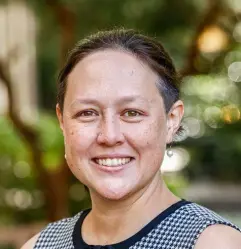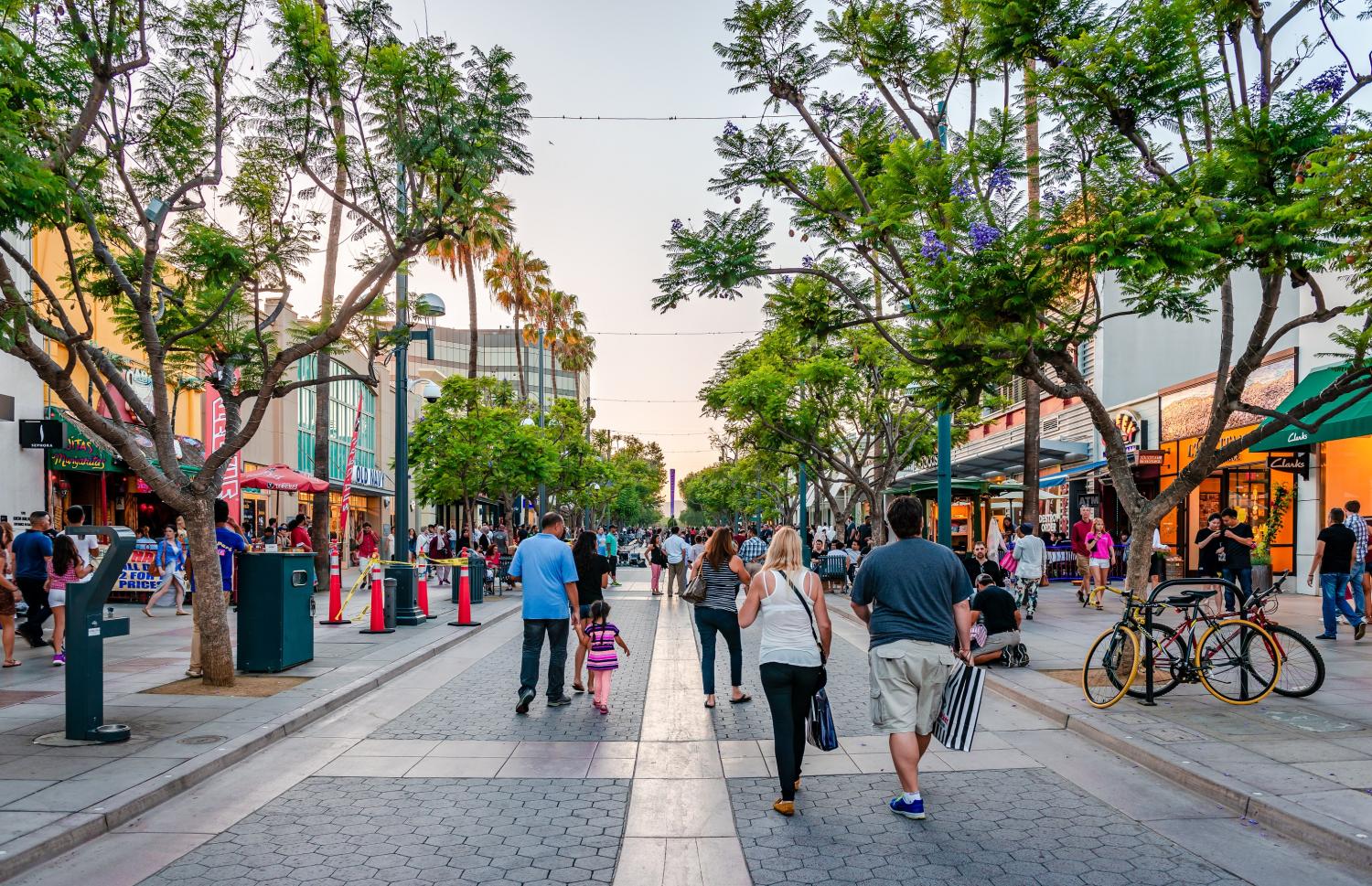Contents
- I. Introduction
- II. Why activity centers matter
- III. Targeting the right places for investment
- IV. What—and where—are activity centers?
- V. Conclusion
I. Introduction
The events of 2020 were a highlight reel of the worst consequences of community disinvestment, devaluation, and sprawl. Low-income people and people of color in urban, suburban, and rural areas alike literally died for living in the “wrong” place—lacking access to grocery stores, parks, basic infrastructure, and medical care as they reckoned with COVID-19 and worsening climate catastrophes. As many peoples’ lives collectively shrank to their neighborhood boundaries, it became clear that the ability to live someplace where you can safely and easily meet your basic needs is a privilege of the few.
Yet even if 2020 felt like a great awakening to many, these challenges existed long before COVID-19 and the ensuing recession. Decades of white flight and suburbanization segregated our regions by race and income and fueled environmental destruction while draining resources, investment, and wealth-building opportunities from urban—and often minority— neighborhoods. The “resurgence” of U.S. cities—and a renewed demand for density and walkability in both urban and suburban areas—has tempered some of these trends, but largely to the benefit of downtowns, waterfronts, and a limited number of other places where the powerful economic effects of clustering businesses, jobs, and entertainment have helped drive new public and private investment. At the same time, other, predominantly minority neighborhoods were left to navigate public and private disinvestment or gentrification and displacement.
Meanwhile, the geography of poverty—long considered a “city” problem—is expanding to include increasingly diverse low-density suburbs, where residents are disadvantaged by limited proximity to jobs and amenities, weaker social safety nets, and governments ill-equipped to address constituents’ needs.
To overcome these patterns of inequity, environmental degradation, and fiscal fragility, public, private, and civic sector leaders must support growth and development patterns that foster networks of neighborhoods in which everyone—regardless of race, income, or geography—has access to opportunity, goods and services, and a healthy physical environment.
To this end, we argue here that these leaders need to identify and invest in what we refer to as activity centers: places within regions where a diversity of economic, physical, social, and civic assets cluster at a clearly defined “hyperlocal” scale. This means local leaders must know where activity centers exist within their cities, towns, and suburbs, and target economic development, infrastructure, and placemaking resources in ways that strengthen these centers, support their growth and development in more equitable ways, improve connectivity within and between them, and ensure that existing residents and businesses benefit from new investment.
By recognizing, valuing, and prioritizing existing place-based strengths, we can support the development of more connected and vibrant communities—and ultimately grow more equitable, prosperous, and resilient regions.
II. Why activity centers matter
The economic, fiscal, environmental, and equity benefits of density and proximity are well documented. Our research confirms that American businesses value proximity when choosing where to locate, as jobs in most sectors are increasingly concentrating hyperlocally in already dense locations. Our colleagues have also demonstrated the benefits of proximity in reducing the fiscal burden of infrastructure in communities, promoting more modal choice and more affordable housing, developing more resilient places, and supporting healthier populations.
The emerging land use planning and economic development strategy of the “15-minute city” sets a benchmark for proximity. It’s a vision based on close access to parks, open space, public transit, retail options, affordable and mixed-income housing, and fresh food for more people in more neighborhoods. But under our current development patterns, only a small subset of people in a small subset of places have the opportunity to live in places with these resources and amenities. By investing in activity centers, growing them, and making them more equitable, this dynamic can change.
Activity centers can serve as the starting point for public, private, and civic sector leaders—in partnership with communities—to leverage transformative placemaking investments that increase access to public and private amenities, promote innovation and productivity, efficiently use infrastructure, and more equitably spread the economic, health, and social benefits of proximity.
III. Targeting the right places for investment
For more regions to equitably distribute these benefits, leaders must know where activity centers are and how to tailor investments to places’ unique strengths, structural challenges, market realities, and community priorities. In today’s fragmented, sprawling regions, a monocentric framework (e.g., placing all bets on downtown development) is wholly inadequate to meet the equity challenges and economic realities of complex, polycentric metro areas. Planners and leaders today have a more complex mapping (and political) challenge to understand and prioritize where to target resources.
Failure to identify the right “where”—or to match the “where” with the right kinds of investments and interventions—yields ineffective place-based investments that either fail to alleviate, or worse, exacerbate, harmful development patterns. Federal place-based policies such as Opportunity Zones, for instance, encouraged investment in some places where assets were already recognized and valued. Other federal programs, such as Empowerment Zones, were narrowly centered on very low-income communities with high, overlapping market obstacles to growth.
There is an opportunity for local leaders (who have the greatest knowledge of their regions) to correct for these mistakes by targeting the places with the most potential to have a transformative impact on community, city, and regional prosperity.
Across regions, some concentrations of activity may be obvious. For instance, downtowns are essential, regionally unique, and globally ubiquitous activity centers that are widely recognized in the development playbook. However, a lack of consensus on what a downtown needs and how to connect downtown prosperity to nearby neighborhoods can stall progress and exacerbate socioeconomic divides within cities.
Some activity centers may be hidden, such as places where assets cluster but where the reach and impact of these assets have been limited by structural disadvantage, discrimination, disinvestment, and other place-based challenges. Other activity centers may be home to a diverse array of good and accessible jobs but suffer from legacy design patterns (wide streets, large surface parking lots, blank building faces) that stifle physical movement, accessibility, and social interaction. Finally, regions may be wrong about which places are activity centers, where their activity centers are located, or what scale they are.
By more strategically focusing on the “where”—using data, local knowledge, and community partnerships to identify places with transformative potential based on their scale and concentration of assets—leaders can foster more communities of opportunity that benefit more people.
IV. What—and where—are activity centers?
This all may sound great in theory, but what actually are activity centers, and how do public, private, and civic sector leaders identify them? The Bass Center for Transformative Placemaking defines activity centers as geographic locations where clusters of assets are significant to their region based on the scale at which they are concentrated and their complexity—that is, the diversity and distinctiveness of the asset mix.
Table 1. Activity centers are a critical mass of scale and complexity
| Low complexity | High complexity | |
| Low-scale concentration | Sprawl | Local-serving places |
| High-scale concentration | Regional-serving monocenters | Activity centers |
Note: These concepts of “regional-” and “local-” serving places are described in more detail by Christopher B. Leinberger in The Option of Urbanism and subsequent research.
In most U.S. metropolitan areas, the vast majority of a region is characterized by sprawl (low-intensity, segregated land uses that are only used for eight hours of the day, or even less). Within this landscape, there are also regional-serving monocenters: locations where one land use operates at a higher concentration, like an industrial park, a big mall, or an airport. These monocenters are used between eight and 24 hours a day. Local-serving places—like historic villages and towns, early streetcar suburbs, and many urban neighborhoods—typically have a mix of assets including shops, rental housing, and government facilities, and are active up to 18 hours a day. Activity centers, on the other hand, are active 18 to 24 hours a day because they contain the largest and most diverse mix of assets.
Some U.S. regions—such as Portland, Ore., San Antonio, Boise, Idaho, Cape Cod, Mass., and Washington, D.C.—have already recognized the importance of identifying concentrations of activity and taken steps to organize their planning, budgeting, and implementation around supporting and growing them. However, each of these bespoke approaches is unique to a local planning effort, and does not enable comparison across regions.
Identifying concentrations of activity in Portland, Ore.In 2019, Oregon’s Metro agency worked with Brookings Metro to develop the Economic Value Atlas (EVA)—a mapping tool to align regional planning and infrastructure investment with economic values. The interactive map examines neighborhood performance across multiple key measures, including market connectivity, inclusivity, and livability. The EVA enables Metro and its regional partners to better understand how their place-based programs—from small business programs to transit investments—can target neighborhoods most in need. |
The Bass Center offers a data-informed framework for identifying activity centers with a shared definition of scale that values proximity, as well as a holistic understanding of assets (encompassing economic, social, civic, and physical assets) that can be used to identify activity centers across multiple regions.
A. Defining scale
The concept of scale is vital to understanding place, and thus it is necessary to speak about it with some precision. As a planning term, “activity” is often thought of as a combination of housing and jobs. The U.S. census is a reliable public source of information about the location of housing at a hyperlocal scale, such as block groups. Prior to 2010, however, the census did not include hyperlocal job data—thus, past research on the economic geography produced by the suburbanization of jobs used absolute thresholds of commercial square footage to define places. For example, Joel Garreau argued in Edge City that “density is back” in the form of suburban employment centers with at least 1 million square feet of office space. In Edgeless Cities, Robert E. Lang countered by observing that the nature of sprawl is such that if you cast a wide enough net (draw a big enough boundary), you can catch enough square footage to have something—if not somewhere.
Scale has been a major challenge for regions in identifying activity centers, leading to, for example, the Metropolitan Washington Council of Governments identifying places as distinct as a regional mall and an entire county seat as activity centers. In order to effectively explore economic geography at the place level, it is advisable to commit to a specific spatial scale—not just a particular mass of economic assets (e.g., offices, jobs).
The pedestrian is a human scale for transformative placemaking. Thus, we define the scale for activity centers as a place that one can traverse in a 10- to 30-minute walk, which encompasses 126 to 1,130 acres (about 0.2 to 1.75 square miles). Holding scale constant makes it possible to identify concentrations of activity at the high end of a distribution in a particular region. Under this definition, leaders from New York to Birmingham, Ala. to Phoenix can identify activity centers that are meaningful in their regional context and use that information to guide decisionmaking.
B. Defining asset types
There are many different kinds of assets, as well as many examples of activity centers that have varied combinations of assets. This is where our definition of activity centers differs from others—rather than understanding “activity” as jobs and housing, it also identifies and values assets such as arts and culture, entrepreneurs, libraries, and historic sites. No single asset is required to be considered an activity center, and it is wise to take a critical eye toward examining which assets—and which communities—have traditionally been undervalued.
Table 2 presents some common asset types and examples. Some assets are easier to systematically inventory and measure than others—but that is not a measure of their relative importance or worth. Moreover, any examination of a place’s assets requires deep coordination with community members and residents on the ground to identify assets that may be overlooked, such as community centers, networks of small businesses, and arts and cultural organizations. The history of planning practice—from economic development to historic preservation—is full of examples in which standards and measurements have been used as tools of discrimination or frameworks for structural racism. Equitable planning must recognize this, avoid replicating these harms, and take a holistic and inclusive approach to asset inventory.
 C. Activity centers on the ground
C. Activity centers on the ground
With a clearly defined scale specified to give a consistent, shared meaning to proximity—as well as an expanded (and nontraditional) understanding of assets—regional leaders can use activity centers to identify places from which to efficiently leverage inclusive economic growth and maximize transformative impact for more people.
Keeping these definitions of scale and asset mix in mind, a diverse array of activity centers can exist within a region across metropolitan, micropolitan, and rural areas alike. As such, the types of investments, policies, and interventions they could most benefit from will vary widely.
Table 3 presents examples of various activity centers and the transformative placemaking interventions they are embarking on, drawing from the Bass Center’s research portfolio. Examples range from an industrial district in South Los Angeles to a rural Main Street community in Kansas to innovation districts seeking to connect nearby neighborhoods to opportunity.
Table 3. On-the-ground examples of established and emerging activity centers
| Activity center | Transformative placemaking in activity centers |
| Goodyear Tract; South Los Angeles | An industrial district with a diverse array of good and accessible jobs within the primarily Black and Latino or Hispanic region of South Los Angeles, where local leaders are implementing place-based economic development strategies to connect residents to employment and obtain community control over industrial properties. |
| Innovation District of Chattanooga | A Tennessee innovation district where stakeholders are undertaking intentional efforts to ensure that low-income and minority residents are key participants in the area’s growth and development. |
| Columbia Gateway; Columbia, Md. | A suburban business park implementing a plan to transform itself into a lively district that meets the changing needs of tenants and workers. |
| New Center; Detroit | A historic district seeking to address the increased displacement of creative communities in the city by introducing a rent structure in which tenants’ rent would remain well below current market rates for office buildings for a three-year period. |
| Downtown Emporia; Kansas | A rural Main Street community implementing efforts to foster its downtown as a walkable, mixed-use hub that supports a concentration of small businesses, increases housing stock, and leverages existing assets for community revitalization. |
| Little Tokyo; Los Angeles | A robust “ethnic community” adjacent to downtown Los Angeles facing affordability and development pressures, and whose residents, businesses, activists, and nonprofits are implementing place-keeping efforts to ensure the neighborhood’s unique cultural and artistic strengths are preserved under community control. |
| University City District; Philadelphia | A West Philadelphia district—home to anchor institutions such as the University of Pennsylvania and Drexel University—implementing intentional, equity-focused initiatives to connect local residents to employment and increase their access and sense of belonging to public spaces in the district. |
V. Conclusion
How we plan places—from the neighborhood to regional scale—matters. It determines the public and private amenities people have access to, their proximity to employment, their chances for intergenerational economic mobility, and how they move from place to place.
Activity centers have the potential to enhance opportunity and connectivity by nurturing investment in the critical mass of places needed to build regional resilience. There is no one-size-fits-all strategy for how to grow activity centers, nor is every activity center starting on a level playing field. Each is a unique combination of assets and needs—and it will take more work, deep community partnerships, and local leadership to tailor investment strategies to these unique circumstances.
In a future publication, the Bass Center will present a methodology and analysis of U.S. metropolitan areas to attempt to map activity centers nationwide using the shared understanding of scale and asset mix, and compare individual and relative regional economic and equity outcomes by the maturity of areas’ activity center networks. This work will further explore the usefulness and impact of activity centers as a unit of observation and intervention in public policy concerned with all aspects of placemaking and development.





